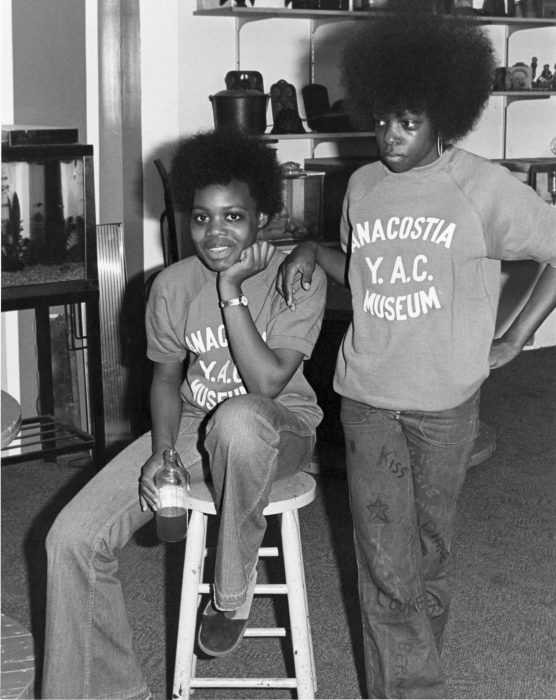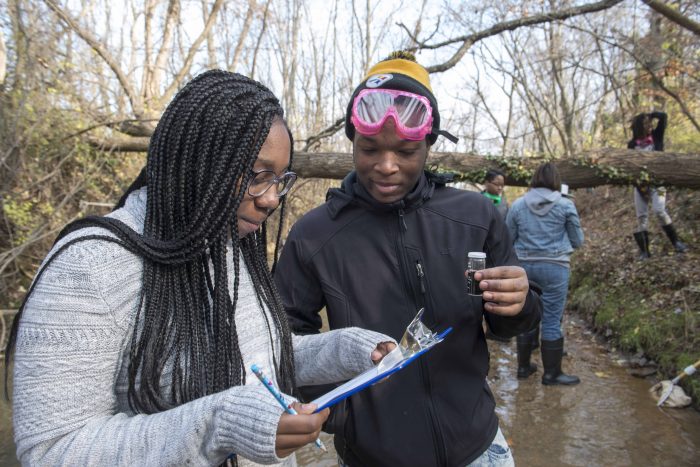A model for engagement
For 50 years, the Anacostia Community Museum has expanded the boundaries of what “museum” means. With a focus on contemporary communities, the museum has convened conversations, enhanced understanding of lived experiences, and strengthened community bonds.
To mark its 50th anniversary, ACM is reenvisioning its future to become a cultural hub of even greater relevance to the people it serves and the local and national partners with whom it collaborates.
“Better than any other institution, a museum can inform, inspire and invoke responses from people that can enhance their existence, challenge their intellect, and give direction to their creative energies.”
—John Kinard, Founding Director (1979)

Garfield Prep Academy Elementary School’s award-winning Drumline performs for Anacostia Community Museum’s 50th Anniversary Open House Celebration Sept. 15, 2017. (Photo by Susana Raab / Anacostia Community Museum)
The 50th anniversary of the Anacostia Community Museum comes at a time of transition and opportunity for the museum and the Smithsonian a whole. The trend among museums everywhere—to understand and engage visitors more fully—reflects changing cultural, technological, economic and social factors. In November, we will present further details of our Strategic Plan, which embraces the need for change and supports innovative concepts under development throughout the Institution. Some of the most dynamic ideas are those being proposed by the Anacostia Community Museum.
Since it opened in 1967, the Anacostia landmark has shown courage and creativity in adapting as its audience evolved. Not surprisingly, its new plan is especially bold and inspired. It seeks to diversify the museum’s constituency and balance traditional exhibitions with innovative, more varied ways of sharing knowledge and telling stories.
Development of the plan began when a committee of museum directors, D.C. mayoral representatives, community stakeholders and constituents were charged with assessing the museum’s current state. The committee collected data about operations, analyzed internal documents and conducted 18 in-depth interviews with other Smithsonian directors, arts and culture thought leaders and stakeholders of the museum. The process culminated with a retreat facilitated by the Office of Policy and Analysis and attended by 45 people who focused on the museum’s future direction, impact and constituency.

Anacostia Neighborhood Museum Youth Advisory Council.
Under the leadership of Zora Martin Felton, director of education and chief advisor, the museum’s Youth Advisory Council was developed in 1967 to engage young people in the work of the museum and the community. Council members participated in all museum activities and created an intensive African American heritage and community service program with museum staff.
Anacostia Community Museum Archives, Smithsonian Institution
Partnerships will be key to the proposal’s success. Organizations within the Smithsonian, including affiliate museums, and educational, cultural, and corporate entities, both local and national, will enable the museum to develop a broader range of activities. The museum will use digital and pop-up exhibitions to expand its outreach and engage people of different backgrounds, in various environments. Although the museum traditionally has focused on the history and culture of African Americans east of the river, future activities will explore a wider range of topics intended to resonate throughout the extensively diverse metropolitan area in a manner relevant to urban communities in general. The proposal supports key elements of the Smithsonian plan, such as adopting a “digital first” strategy.
In developing ideas, staff members and stakeholders of the Anacostia Community Museum built on core strengths of the facility, such as its deep commitment to audience engagement, independent spirit, flexibility, and willingness to explore new concepts. Now, after 50 successful years, the museum is branching out and taking some chances.

December 13, 2014: Students from the Anacostia Community Museum’s Citizen Scientist Program explore Lower Beaverdam Creek, a tributary of the Anacostia River. The program is a partnership between the museum, United Planning Organization Youth Services Division and the Smithsonian Environmental Research Center. Here Diamond Carter and Mike Thomas record data collected in the creek. (Photo by Susana Raab / Anacostia Community Museum)
Since its establishment in 1967, the Anacostia Community Museum, has earned its well-deserved reputation as pioneer. In recognition of its 50th Anniversary, and on behalf of the entire Smithsonian family, I would like to extend congratulations and heartfelt wishes for its continuing success.
Posted: 2 October 2017
-
Categories:
Anacostia Community Museum , From the Secretary , History and Culture , News & Announcements



